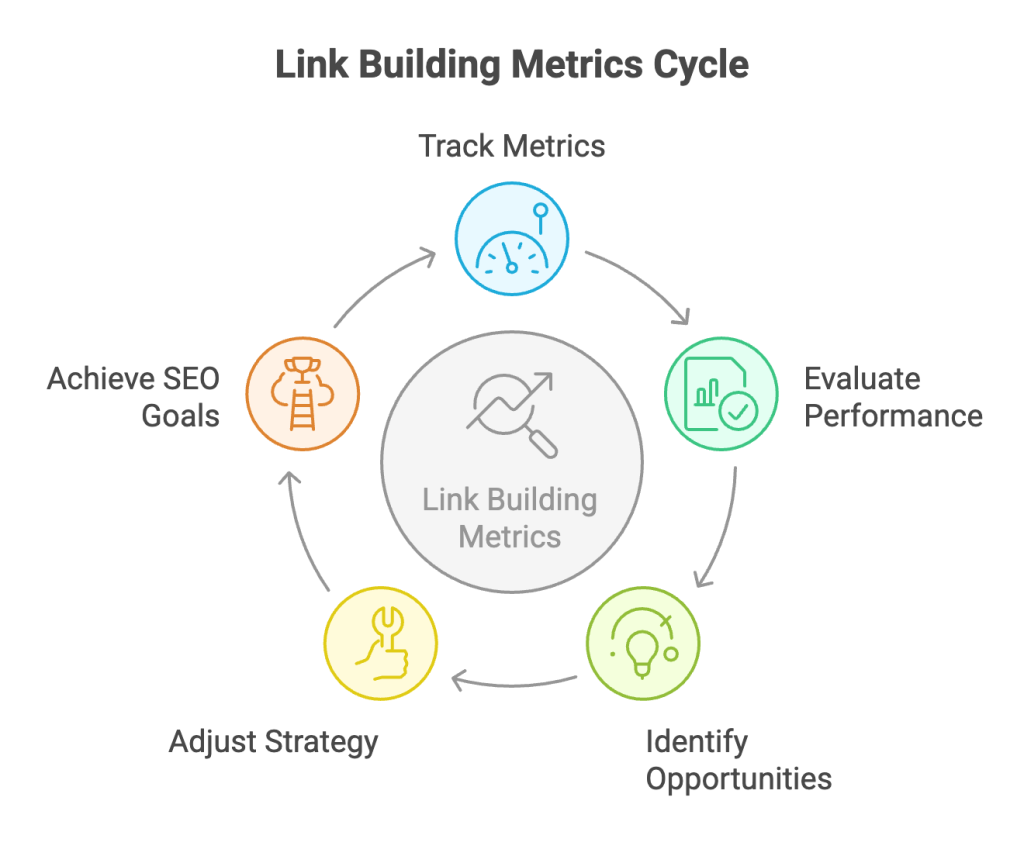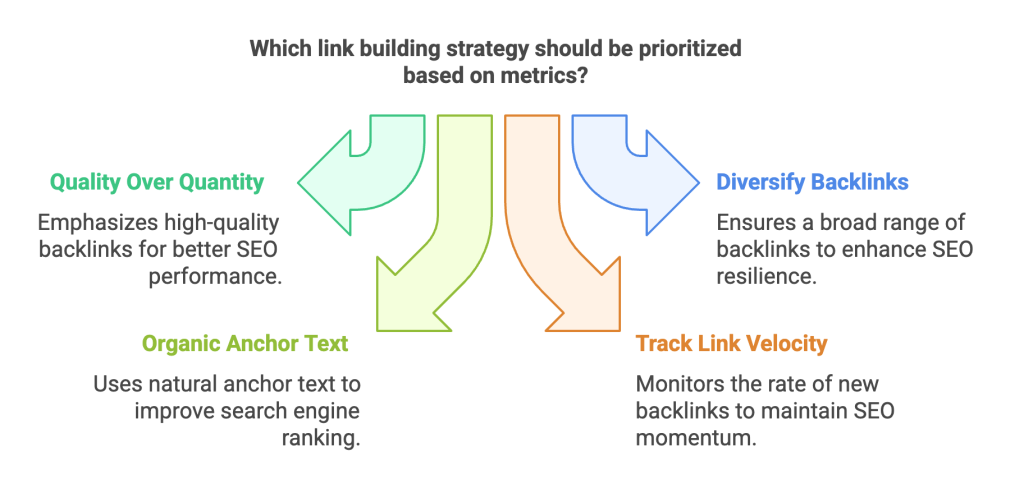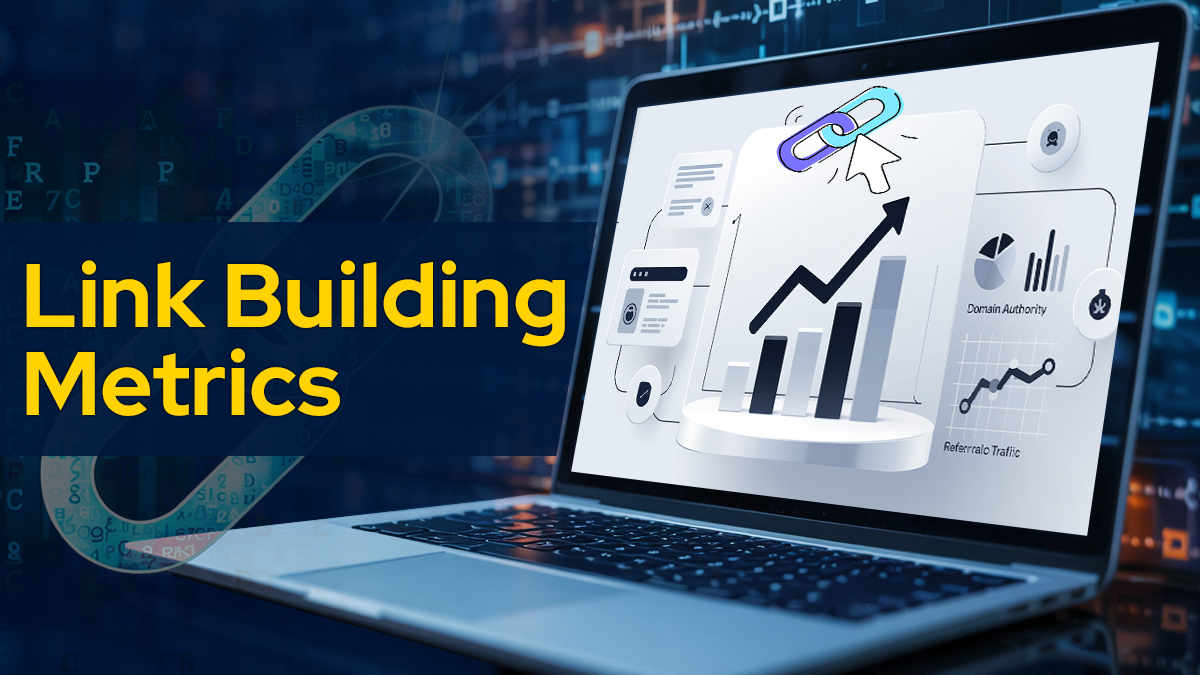In the constantly changing world of SEO, getting links to your site is still a key part of a good plan. But, just getting lots of backlinks isn’t enough for your link-building to be successful. You need to pay attention to the right metrics to make sure those links matter and help your website succeed in the long run.
Link building metrics help you see how well your backlinks are working and how they affect your site’s authority and rankings. They give you useful information about how good, relevant, and varied the links you are getting are.
This helps you improve your strategy and make your efforts better. By keeping an eye on important metrics, the number of websites linking to you, and the types of link text used, you can check how strong your backlinks are.
And, this will make sure you’re creating a reliable link network. In this post, we will talk about why it’s important to keep an eye on link building metrics and how you can use them to improve your SEO results.
What are Link Building Metrics?
Link building metrics are metrics that help you see how well your backlink campaigns are working. These measurements help you understand how good your link profile is by looking at things like search rankings, website visits, and the strength of your domain.

By keeping track of them, you can find valuable links, spot harmful links, and change your plans to get the best links. They help you see if your efforts are helping you achieve your long-term SEO goals and increase your website’s ranking and traffic.
Guest posting services evaluate various link building metrics—such as domain authority, relevance, and traffic—to ensure the creation of high-quality, SEO-friendly backlinks.
Importance of Tracking Link Building Metrics

Data-Driven Decision Making
Keeping track of link building metrics helps you make decisions based on actual data instead of wild guesses or feelings. When you check metrics like domain authority, page authority, and trust flow, you can understand how valuable your backlinks are.
These measurements help you see how strong and trustworthy the links you are getting really are. For example, if you’re getting links mostly from websites that are not well-known, you might see little or no improvement in your rankings.
By keeping an eye on these metrics all the time, you can see what is going well right away, which helps you improve your plan. Without these measurements, you might spend time creating links that don’t really help, while losing chances to grab valuable ones.
Helps Monitor Link Profile Health
Having a good mix of links is important for maintaining strong SEO results over time. Keeping an eye on link building metrics helps you understand how strong your link profile is. It can also help you spot problems early, before they hurt your rankings.
For example, the number of different websites that link to you shows how varied your backlinks are. If you see that many of your links come from just a few websites, it might mean you depend too much on those sources, which could seem suspicious to search engines.
Also, metrics like the comparison of dofollow to nofollow links can help you understand how natural your collection of links looks. Checking the quality and importance of your links often makes sure you are getting links from trusted and related sources.
Improves Allocation of Resources
Link building can take much effort from your side. It usually needs a good amount of time, money, and energy. By keeping track of link building metrics, you can make better decisions on how to use these resources.
For example, if you find that writing guest posts or fixing broken links, are bringing in better quality backlinks than other methods like adding links in directories or leaving spam comments, you can focus more time and effort on the more successful strategies.
Also, keeping track of your metrics helps you spot problems or weak strategies early. If you’re spending money on a tool or service that isn’t giving you better links, you can use that money for something else.
Also Read: How To Do Competitor Backlinks Analysis To Rank #1 on Google
Stay Ahead of Competitors
It’s important to keep an eye on your own link building progress, but it’s also good to watch what your competitors are doing. By monitoring the types of websites that link to your competitors, you can learn what kinds of sites are interested in them and what content gets a lot of good links.
With SEO tools, you can find new chances to get links that your competitors are using. For example, if a competitor is regularly getting links from well-respected industry blogs or news sites, you can look for similar chances to do the same.
Also, checking your competitors’ statistics helps you find weaknesses in their links, like if they depend too much on low-quality ones, which you can take advantage of. By keeping an eye on how your competitors build links, you can change and improve your own strategy.
Long-Term SEO Results
Keeping track of link building metrics helps you see how your work improves SEO results.
Metrics like domain authority, page authority, and organic search traffic help you see if your link-building efforts are really improving your website’s rankings and getting more visitors.
Over time, having strong backlinks makes your website more trusted, which helps it rank better in search engine results. Keeping track of these metrics lets you see how well your link-building efforts are working. It helps you find out if your plan is giving you lasting results.
If you see that getting more good-quality backlinks is leading to more visitors and better search rankings, it means your efforts are paying off. If you don’t keep track of things, you might overlook important changes and information.
8 Metrics to Measure Link Building

Backlink Count
The most important thing to measure is how many links you have created. The number of links to your website helps it rank better, but having good links is more important than just having a lot of them.
You can use this number to see how your website stacks up against others. Do you have more links than most websites? Are you falling behind your biggest competitor? This is a good reason to improve your metrics.
Knowing the exact number of backlinks you have compared to your competitors can show why your rankings are different. If your competitor has a lot more backlinks than you do, they could appear higher in search results, even if their content isn’t as strong.
Domain Authority
To easily track link building metrics, you can look at your domain authority. Your domain authority or domain rating indicates how trustworthy and reputable your website is. This score is decided by a few important things, like:
- The amount and quality of backlinks (not counting mentions without links)
- Content quality and relevance
- User experience
- Website age
- How often your site ranks in search results
Your domain authority isn’t a factor that Google uses to rank sites, but it is closely linked to how high your website ranks in results pages. The stronger your website’s domain, the better your chances of appearing at the top of search results.
So, it’s important to keep an eye on this over time. You can use free SEO tools like Ahrefs or Moz to see how strong your website is and compare it to other websites in your field.
Number of Referring Domains
If many websites link to your site, it shows that your site is trustworthy and important. However, it also matters how good those linking websites are. When keeping an eye on this measure in your online PR campaign, be sure to consider:
Domain rating: Ideally, the websites linking to you should have a higher rating than your own website. A score of over 70 is best, but it might not be possible if your DR is low. Relevance: Are the websites linking to you related to your topic? Getting links from unrelated sites can hurt your SEO and make Google think your website is not trustworthy. Referring domain links: If a page on another website has many links, it won’t be as strong or valuable as one that has only two or three links.
Anchor Text
The part of the link you can click on is called the anchor text. It helps crawlers organize information and tells users what to expect on a linked page. When talking about link building, anchor text matters for two main reasons:
- It helps you check your website’s links and find any bad link attacks from competitors trying to hurt your site’s reputation.
- It helps you evaluate the link quality of potential partners. Any website you want a backlink from should have different types of anchor text.
Using too many keyword-rich links looks like spam and can harm your website’s search engine ranking. Most SEO tools let you see the variety of anchor text you use and help you avoid bad backlinks that have irrelevant or too many keywords.
Dofollow vs Nofollow
There are two kinds of backlinks, which are dofollow and nofollow links. DoFollow links help crawlers find and link back to your website or blog. You want these kinds of backlinks because they make your website stronger, help it show up better in results pages, bring in more visitors, and increase its reputation.
NoFollow links have a tag that tells bots not to link back to your website. These don’t help your domain rating and are mostly used for sponsorships or paid chances, but they can be good for making more people know about your brand.
Linking Root Domains
Linking root domains is the count of different websites that link to your site, rather than just counting the total number of links. For example, if a website mentions your site in five different articles, you would have five links, but they all come from just one main website.
The count of different websites that link to you is a better sign of popularity and trust than just the total number of links. If you were running for president, you would want lots of votes from many different people, not just lots of support from the same person.
Getting many links from reputable websites is beneficial, but there’s a limit to how much it helps. Instead, you should try to get links from a variety of different sources.
Organic Traffic
Check how many people come to your site each month to see if your backlink efforts are working. You can see if your link-building efforts are working by checking how many people click on your links, how many times they appear, and how much traffic comes from search engines.
Even if getting more visitors to your website isn’t your main goal for the campaign, getting important links from reputable websites can help increase your organic traffic. This kind of traffic is always better than traffic received through paid ads, since it is long lasting and you don’t have to spend money for it.
Ranking Change
A good way to check how well your link building is working is to look at the changes in your rankings, especially for important keywords. Here’s a simple way to keep track of this metric:
- Choose important keywords that matter for your website’s SEO plan.
- Use an SEO tool to find out your starting ranking for those keywords, it’s okay if the number is low.
- Check your rankings often (every day, week, or month, based on your competition and niche).
- Look for local and global relevance. Are you doing better in some areas after a link is active?
- Check the ratings on your phone and computer because they might be different.
- Keep track of changes, especially after a new backlink is added to a website.
Monitoring changes in rankings helps you change your link-building plan so you can focus on the best chances that match your marketing goals. If you see your rankings go down while working on your backlinks, think about why that’s happening and make the needed changes.
Also Read: The Do’s and Don’ts Of Link Building
Link Building Best Practices Based on Metrics

Focus on Quality Instead of Quantity
Link building metrics show that having good quality backlinks is much more important than just having a lot of them. By monitoring them, you can see which backlinks are really useful. Good links come from important and related websites.
These links are more helpful for your SEO than having many links from less reliable sites. For example, getting one link from a trustworthy website is usually better than getting ten links from less reliable sites.
Keeping track of important metrics helps you focus on getting links from trusted and respected sources in your field. This way, your link profile stays strong and dependable. Try to get links from sites that are related to your niche, since these links will be more helpful.
Diversify Your Backlinks
A good way to build links is to have a variety of websites that link to you. By checking how many different websites link to yours, you can make sure you’re not depending too much on just a few of them.
Having different types of backlinks shows crawlers that your content is useful in many areas and industries. Having a variety of sources can help reduce the risk of getting a penalty if some of the websites linking to you lose their credibility.
To create a varied link profile, get backlinks from different places like trusted blogs, news websites, industry directories, discussion forums, and social media. Monitoring the metrics helps you see how different links impact the overall condition of your website.
Use Organic and Relevant Anchor Text
The words used in backlinks are important to check for successful link building. Using the same keywords too often in links can cause problems and might get your website in trouble with search engines.
Instead, try to use a good mix of different types of anchor text, like brand names, general phrases, and phrases that are related to the topic. By monitoring things like the types of words used in your links, you can make sure your backlinks look natural and not like spam.
Using relevant and appropriate anchor text helps improve the linked content, making it better for users and signaling to search engines that it is important. Make sure your backlinks use organic words, as this will help improve your SEO in the long run.
Keep Track of Link Velocity
Link velocity is how quickly you get new backlinks. It’s important to keep track of this when building links naturally. A quick increase in backlinks might look strange to bots of search engines and could result in penalties from their algorithms.
By keeping a close watch on how many links you get over time, you can make sure that your link-building is natural. To keep a good link profile, aim for a slow and steady increase in links instead of trying to get a lot of them all at once.
You can do this by getting links gradually, reaching out to others regularly, writing guest posts, or running content marketing campaigns. Track how many new websites link to you and how your backlinks change over time. Use this information to improve your strategy.
Remove Toxic Links
One important part of building links is to keep your link profile healthy by checking it often and removing harmful or low-quality links. These kinds of backlinks can hurt your website’s SEO and might lead to a manual penalty from Google if you don’t take care of them.
By checking metrics like Spam Score and referring domains, you can find links that are hurting your SEO efforts. Once you find bad links, using Google’s Disavow Tool helps stop them from affecting your rankings.
This process also involves looking for any unusual patterns in link text or links from low-quality sites that don’t relate to your content. Regular link checks keep your links clean, appropriate, and strong, which helps improve your site’s overall SEO performance.
Final Thoughts
Link building isn’t only about how many links you have; it’s also about having good ones that matter and help you grow in a smart way. The right link building metrics give you the information you need to create a strong and trusted backlink profile.
This helps bring more people to your site and improves your search rankings. By keeping an eye on important metrics, and the number of websites linking to you, you can better see which backlinks help your SEO and which ones might need more work.
Regularly checking and analyzing your performance helps you change your strategies and stay prepared for possible SEO problems, like link penalties or a lack of new backlinks.
Link building metrics are important not just for measuring success, but also for improving your long-term SEO strategy. By using data to guide your link-building efforts, you can create a link profile that brings good results and helps your website grow over time.
FAQs
How do domain authority and page authority impact SEO?
DA looks at how strong a whole website is, while PA looks at the strength of each page on that website. High DA and PA scores mean that a website is trusted by crawlers and is more likely to show up in search results for related topics. When you get backlinks from websites that have a good reputation, it helps give some of that credibility to your own site. This can make it more likely for your site to show up in results pages.
How often should I check link building metrics?
It’s important to regularly check your link-building metrics to make sure your backlinks are in good shape and that your link-building work is successful. It’s best to check your metrics at least once a month. This frequency lets you keep track of changes in your backlinks, spot any big increases or decreases in them, and see if some methods work better than others. Keeping track of your link-building progress over time helps you notice problems early, like getting harmful backlinks or using the same anchor text too much.
What is link velocity and why does it matter?
It is how fast you get new backlinks in a certain amount of time. A natural link velocity usually means that the number of backlinks to your site increases slowly and steadily as your site becomes more well-known and trusted. Getting a lot of links all at once, especially from not-so-good websites, can make bots suspicious and might result in penalties for unnatural link-building. Keeping an eye on how quickly you’re getting links is important because it helps make sure your link-building is natural and lasting.
How can I use link building metrics to rank higher than my competitors?
Link building metrics help you improve your own links and understand how your competitors are getting their backlinks. SEO tools help you see where your competitors get their website links, what words they use for those links, and how good those links are. By looking at their backlinks, you can find weaknesses in your own backlink plan. For example, if your competitor is getting good backlinks from respected blogs in your field, you can try to reach out to those same blogs to get links for yourself.
Can link building metrics help boost the traffic to my website?
Yes, link building helps increase the number of visitors to your website. Good backlinks from trustworthy websites help make your site more reliable and increase its chances of ranking higher in search results. As your rankings go up, more people will see you in search results, which brings more visitors to your site for free. By looking at things like where links come from and how good they are, you can work on getting backlinks that will help your website traffic the most.


























